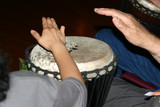Go Global: Adding World Percussion to a Drum Set
Drummers all have one thing in common: we love exploring the sound of percussion. That’s why we always want more drums, cymbals and why we love accent percussion. We covet our case full of drum sticks, mallets and brushes, and we cannot wait each year for the latest bass pedal release. We are always evolving our skills, our “sound” and the next iteration our ultimate drum set.
Drum sets, for some, can be limiting. Sure, there are thousands of different snare drums, bass drums and all of the other “regular” faces. But, we’ve heard the magic of Bonzo when he added some congas to his drum set. We love the sound of Sublime or Godsmack. Some of us really just started out playing Latin jazz and we cannot help but want to be Tito Puente while we’re jamming with friends. When a standard drum set isn’t enough, you may be ready to branch out and get global and add some world percussion into the mix.
Bongos are almost so perfect to add to a drum set, you may be wondering why they weren’t already part of the rig. Mostly, because bongos are considered hand drums, and that’s where their best sound comes from – your hands. But, you can also use sticks, mallets or brushes on them while behind your set, adding a snazzy “pop” when you’re doing a tom roll, just for fun.
Timbales, of course, are the jelly to a standard drum set’s peanut butter. Technically, timbales are really snare drums without the wires… or, snare drums are timbales that have had snares added. Either way, they’re pretty interchangeable on a drum set, can be played with drum sticks and the difference in tone might be just the sound you’ve been searching for.
Congas are a little more difficult to integrate into a drum set, but, not impossible. It is rare that a person is seen playing congas with sticks – it isn’t recommended by anyone and a trained congocero might weep if they saw that happen. That’s why if you’re ready to add some salsa into your R&B or rock, you just need to place your congas a little to the side of the snare or toms, stand up and be ready to play them as the drum gods intended – with your hands.
Djembe drums can also be a part of a drum set, adding a depth to the rhythm and an acoustic feel to the groove. Much like conga drums, djembes shouldn’t be played with sticks, but, they are usually small enough to add to your drum set and still play while seated.
Cajon drums may be ideal for drum sets, as well, especially considering the foot pedal possibilities with these box drums. Plus, if you’re really into a show, you can drag it to the front of a stage for a little “unplugged” action that is sure to be a fan favorite.
Really, if you want to add any kind of drum to your drum set, you should do it. World percussion and hand drums are great representations of ancestry and culture – even if you’re not a descendant of the country of your preferred hand drums. They still represent the overall history of drums and percussion instruments, and there’s no reason not to have a little “something old, something new” in your groove.
Let’s face it, as hand drum and world percussion fans, the tapestry of tone that is possible with multi-cultural instruments is profound. It grabs everyone’s attention and finds a way to keep the focus on the rhythm, especially as that beat is punctuated or built up into a crescendo of percussive resonance that is truly a tribute to your own worldly and creative genius.
Recent Posts
-
X8 Drums Play-Along Backing Tracks
The new X8 Play-Along Series is being produced for our musician friends wanting a fresh way to work …9th Feb 2025 -
What is the Best Size Djembe for Beginners?
If you're new to the world of percussion and interested in learning the djembe, you're in for a t …16th Jul 2024 -
The Benefits of Becoming a Drumming Teacher: Transforming Passion into Profession
Why become a drumming teacher? Becoming a drumming teacher is an excellent way to share your pas …22nd May 2024



